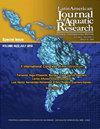在热带东墨西哥太平洋一个几乎没有研究过的深岩礁中大型藻类覆盖的评估
IF 0.8
4区 农林科学
Q3 FISHERIES
Latin American Journal of Aquatic Research
Pub Date : 2023-02-28
DOI:10.3856/vol51-issue1-fulltext-2920
引用次数: 0
摘要
在过去的三十年中,对墨西哥热带太平洋珊瑚礁中底栖生物群落的生物多样性的研究很少。本研究描述了该地区深岩礁中藻类和无脊椎动物的丰度和分布。2012年取样深度为20 m,随机放置50×50 cm样方。此外,还对每个样方进行拍照,以量化生物的覆盖范围。在整个研究中,藻类是最丰富的群体(17748.5 cm m-2),其中外壳钙化(6350.9 cm m-2),草皮(3040.3 cm m-2)和较大的关节珊瑚(2700.9 cm m-2)的覆盖率最高。无脊椎动物中,虫纲动物(1153.3 cm m-2)和珊瑚(746.7 cm m-2)的覆盖率较高。在垂直和水平基质上均发现了所有藻类群。非趋势对应分析表明,水平基质和垂直基质上的珊瑚普遍存在较大的铰接珊瑚和未钙化的覆壳珊瑚群。这些丰度和分布模式代表了对该地区岩石礁的首次定量研究。考虑到人类活动对沿海地区的快速影响,以及对礁石的研究很少,显然需要长期监测计划来建立珊瑚礁群落的模式和过程,这对保护计划很有用。本文章由计算机程序翻译,如有差异,请以英文原文为准。
Assessment of macroalgae coverage in a scarcely studied deep rocky reef in the tropical eastern Mexican Pacific
The biodiversity of epibenthic communities in rocky reefs in the Mexican tropical Pacific has been studied minimally during the past three decades. This study describes the abundance and distribution of algae and invertebrates in a deep rocky reef from this region. Samples were taken at 20 m depth in 2012 by randomly placing 50×50 cm quadrats. Also, photographs were taken of each quadrat to quantify the coverage of organisms. Throughout the study, the algae were the most abundant group (17748.5 cm m-2), of which encrusting calcified (6350.9 cm m-2), turf (3040.3 cm m-2), and larger-sized articulated corallines (2700.9 cm m-2) had the highest coverage. Regarding invertebrates, zoanthids (1153.3 cm m-2) and corals (746.7 cm m-2) had high coverage. All of the algal groups were found on vertical and horizontal substrates. The detrended correspondence analysis showed that larger-sized articulated corallines and encrusting not calcified groups were prevalent on the horizontal substrate and corals on the vertical substrate. These abundance and distribution patterns represent the first quantitative study of rocky reefs from the region. Considering the rapid influence of human activities in this coastal zone and the fact that rocky reefs have been minimally studied, there is a clear need for long-term monitoring programs to establish reef communities' patterns and processes, which are useful in conservation programs.
求助全文
通过发布文献求助,成功后即可免费获取论文全文。
去求助
来源期刊

Latin American Journal of Aquatic Research
FISHERIES-MARINE & FRESHWATER BIOLOGY
CiteScore
1.70
自引率
10.00%
发文量
44
审稿时长
4-8 weeks
期刊介绍:
Latin American Journal of Aquatic Research- LAJAR is the continuation of the journal Investigaciones Marinas (1970-2007) and is published since 2008 by the Escuela de Ciencias del Mar, Facultad de Ciencias del Mar y Geografía of the Pontificia Universidad Católica de Valparaíso. LAJAR is an “Open Access” journal that publishes in English language, original research articles, reviews and short communications on aquatic science, which contain the results of research conducted in aquaculture or in oceanic and coastal marine waters of Latin America.
The following topics are considered: Physical Oceanography, Chemical Oceanography, Marine Biogeochemistry, Marine Pollution and Toxicology, Marine Geology and Geophysics, Biological Oceanography, Fisheries and Aquaculture.
 求助内容:
求助内容: 应助结果提醒方式:
应助结果提醒方式:


